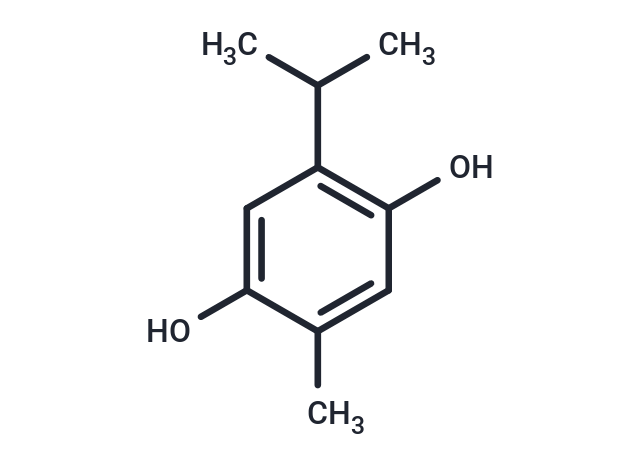- Remove All
 Your shopping cart is currently empty
Your shopping cart is currently empty
Thymohydroquinone
Thymohydroquinone (Thymoquinol) is a monoterpenoid phenolic compound found in thyme, oregano, and other plants in the labiaceae family. Thymohydroquinone inhibits cancer cell growth, reduces oxidative stress and modulates inflammatory responses, scoured 2, 2-diphenyl-1-PicrylHydrazyl radicals in a cell-free assay (IC50 = 2.4 μg/ml), In the oxygen radical absorption capacity (ORAC) test at concentrations of 1.6 to 6.4 μg/ml, Its Trolox value was 2.6. Thymus hydroquinone inhibited the growth of A2780, OVCAR-8 and CIS-A2780 ovarian cancer cells (IC50 were 3.1, 8.9 and 9.8 μM, respectively) and human ovarian immortalized epithelial cells (IC50 = 14 μM). It also inhibited Plasmodium falciparum in vitro (IC50 = 15.9 μM).

Thymohydroquinone
| Pack Size | Price | Availability | Quantity |
|---|---|---|---|
| 1 mg | $48 | In Stock | |
| 5 mg | $98 | In Stock | |
| 10 mg | $163 | In Stock | |
| 25 mg | $276 | In Stock | |
| 50 mg | $397 | In Stock | |
| 100 mg | $598 | In Stock |
Product Introduction
| Description | Thymohydroquinone (Thymoquinol) is a monoterpenoid phenolic compound found in thyme, oregano, and other plants in the labiaceae family. Thymohydroquinone inhibits cancer cell growth, reduces oxidative stress and modulates inflammatory responses, scoured 2, 2-diphenyl-1-PicrylHydrazyl radicals in a cell-free assay (IC50 = 2.4 μg/ml), In the oxygen radical absorption capacity (ORAC) test at concentrations of 1.6 to 6.4 μg/ml, Its Trolox value was 2.6. Thymus hydroquinone inhibited the growth of A2780, OVCAR-8 and CIS-A2780 ovarian cancer cells (IC50 were 3.1, 8.9 and 9.8 μM, respectively) and human ovarian immortalized epithelial cells (IC50 = 14 μM). It also inhibited Plasmodium falciparum in vitro (IC50 = 15.9 μM). |
| Targets&IC50 | CIS-A2780 cells:9.8 μM, OVCAR-8 cells:8.9 μM, A2780 cells:3.1 μM |
| In vitro | Thymohydroquinone, a quinone compound derived from Nigella sativa seeds, exhibits a wide range of biological activities. It demonstrates potent scavenging activity against DPPH free radicals in a cell-free assay (IC50 = 2.4 μg/ml). In addition, thymohydroquinone exhibits a Trolox equivalent value of 2.6 in an oxygen radical absorbance capacity (ORAC) assay, when tested at concentrations ranging from 1.6 to 6.4 μg/ml. [1] Thymohydroquinone inhibits the growth of A2780, OVCAR-8, and CIS-A2780 ovarian cancer cells (IC50s = 3.1, 8.9, and 9.8 μM, respectively), as well as immortalized human ovarian epithelial cells (IC50 = 14 μM).2 It is also active against P. falciparum in vitro (IC50 = 15.9 μM).[2] |
| In vivo | In vivo evaluation of the antitumor efficacy of Thymohydroquinone (THQ) was conducted using two murine tumor models, namely fibrosarcoma (FsaR) and squamous cell carcinoma (SCC VII). The antitumor effect of THQ was assessed by comparing the tumor growth kinetics between animals treated with four intratumoral injections of THQ at a dose of 5 mg/kg and control animals. In the in vitro study, THQ exhibited statistically significant cytotoxic activity (p < 0.01), which was dose-dependent. Moreover, the cytotoxic activity was more pronounced against tumor cells compared to L929 fibroblasts. The in vivo evaluation of THQ's antitumor activities resulted in a tumor growth inhibition (TGI) of 52%, and this effect was statistically significant (p < 0.05).[3] |
| Alias | Thymoquinol |
| Molecular Weight | 166.22 |
| Formula | C10H14O2 |
| Cas No. | 2217-60-9 |
| Smiles | C(C)(C)C1=C(O)C=C(C)C(O)=C1 |
| Relative Density. | 1.0060 g/cm3 (Estimated) |
| Storage | Powder: -20°C for 3 years | In solvent: -80°C for 1 year | Shipping with blue ice. |
| Solubility Information | Ethanol:PBS (pH 7.2) (1:9): 0.1 mg/mL (0.6 mM), Sonication is recommended. DMSO: 0.9 mg/mL (5.41 mM), Sonication is recommended. Ethanol: 1.8 mg/mL (10.83 mM), Sonication is recommended. DMF: 1 mg/mL (6.02 mM), Sonication is recommended. |
Calculator
In Vivo Formulation Calculator (Clear solution)
Dose Conversion
Tech Support

Copyright © 2015-2025 TargetMol Chemicals Inc. All Rights Reserved.



